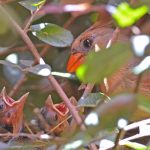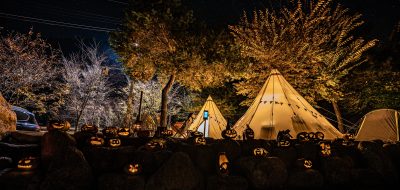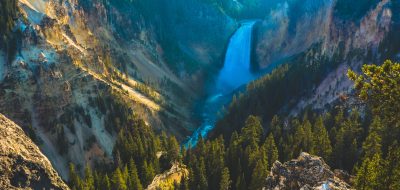Top 10 North American Natural Landmarks to see before 2010
No, they’re not going anywhere, but with careful planning you could feasibly see them all by the end of next year (especially all you full-timers out there). I’ve chosen them at random from different regions of North America for their environmental and geologic variety. Think I left some out? Post a comment with your Top 10 parks!
 10. Crater Lake National Park, Oregon: Situated at the top of the Cascade Mountain Range in southern Oregon, the lake was formed when snowmelt filled the volcanic basin left over from the eruption of Mount Mazama more than 7,000 years ago. The picturesque lake is a deep, pure blue with two islands in the middle. At 592 meters, it’s the deepest lake in the U.S. and the 7th deepest in the world. Entrance is $10 per vehicle for a 7-day pass. Mazama Campground has 200 sites with running water, flush toilets, picnic tables and fire rings, but no hookups. The campground is open from mid-June to early October, weather permitting. See current facilities information.
10. Crater Lake National Park, Oregon: Situated at the top of the Cascade Mountain Range in southern Oregon, the lake was formed when snowmelt filled the volcanic basin left over from the eruption of Mount Mazama more than 7,000 years ago. The picturesque lake is a deep, pure blue with two islands in the middle. At 592 meters, it’s the deepest lake in the U.S. and the 7th deepest in the world. Entrance is $10 per vehicle for a 7-day pass. Mazama Campground has 200 sites with running water, flush toilets, picnic tables and fire rings, but no hookups. The campground is open from mid-June to early October, weather permitting. See current facilities information.
 9. Mammoth Cave National Park, Kentucky: The world’s longest cave network extends for more than 360 miles below the mountains in southern Kentucky and is home to many strange nocturnal creatures. Tours of the cave have been offered since 1816. Hiking and riding trails and the Green and Nolin rivers offer hours of outdoor recreation above ground. Mammoth Cave Campground has no hookups but each site has a fire ring, picnic table and a paved parking area. Full service restrooms and a dumping station are available. Each site costs $17 per night with a 14-day limit. View camping regulations. See for yourself why Mammoth Cave ranks #17 on the Good Sam Club list of “20 Trips Every RVer Should Take” (details in Highways November 2007).
9. Mammoth Cave National Park, Kentucky: The world’s longest cave network extends for more than 360 miles below the mountains in southern Kentucky and is home to many strange nocturnal creatures. Tours of the cave have been offered since 1816. Hiking and riding trails and the Green and Nolin rivers offer hours of outdoor recreation above ground. Mammoth Cave Campground has no hookups but each site has a fire ring, picnic table and a paved parking area. Full service restrooms and a dumping station are available. Each site costs $17 per night with a 14-day limit. View camping regulations. See for yourself why Mammoth Cave ranks #17 on the Good Sam Club list of “20 Trips Every RVer Should Take” (details in Highways November 2007).
8. Riding Mountain National Park, Manitoba: The park sits 1500’ above the surrounding prairie countryside on a rolling plateau covered with aspen, bogs, grasslands and hardwood forests. Such diverse habitats attract more wildlife than any other part of the province, so you’re sure to have a sighting or two. Try your hand at any of a wide range of outdoor activities on land or water, then take a break and watch for moose, elk, bears, foxes and other critters (remember to keep your distance). The park is open year-round but the visitor centre is closed for winter from Oct. 13 to May 21. Wasagaming Campground has full service campsites for about CA$40 per night. See Camping Reservation Info.
 7. Badlands National Park, South Dakota: Marvel at the craggy buttes and pinnacles of this strange land full of marine reptile fossils. Though it may look inhospitable, Badlands is also home to the largest protected mixed-grass prairie in the U.S., where four species of native wildlife have been successfully reintroduced over the years. Cedar Pass Campground offers level sites with covered picnic tables for $10 per night. No showers or hookups are available, but there is a dump station, flush toilets and cold running water. No campfires are permitted due to fire danger. Download the 2008 Visitor Guide PDF.
7. Badlands National Park, South Dakota: Marvel at the craggy buttes and pinnacles of this strange land full of marine reptile fossils. Though it may look inhospitable, Badlands is also home to the largest protected mixed-grass prairie in the U.S., where four species of native wildlife have been successfully reintroduced over the years. Cedar Pass Campground offers level sites with covered picnic tables for $10 per night. No showers or hookups are available, but there is a dump station, flush toilets and cold running water. No campfires are permitted due to fire danger. Download the 2008 Visitor Guide PDF.
6. Glen Canyon National Recreation Area, Arizona/Utah: 1.2 million acres of beautiful red desert canyons and rock formations contrast with the brilliant blue/green water of manmade (often controversial) Lake Powell. You’ll be forever grateful if you bring a boat to this park (just leave the zebra mussels and quagga mussels at home) to cruise the slot canyons or enjoy a floating picnic while enjoying the scenery. You can also hike, bike, fish, and kayak. Just remember to drink lots of water to guard against the desert sun and heat. Also, be aware of flash-flood dangers during the monsoon season (mid-late summer & into fall). Entrance fee is $15 per vehicle, good for 7 days. Stay at one of the campgrounds operated by Lake Powell Resorts & Marinas, which offer full hookups and other amenities at sites of varying length (up to 50’).
 5. Devil’s Tower National Monument, Wyoming: The tower stands 1267’ above the Belle Fourche River and is made of igneous crystalline rock columns, which reflect sound when small pieces are struck. The hard rock tower was exposed when surrounding sedimentary rock eroded away. Native American tribes have long held the tower to be sacred. It’s a popular spot with rock climbers and is a 2.5 hour drive from Mount Rushmore, Ft. Laramie and Jewel Cave. Camping costs $12 per night and vehicle entrance costs $10 per vehicle for 7 days. Sites accommodate RVs up to 35’ (big rigs should think of staying at Mountain View RV Park in nearby Sundance) but there are no hookups, showers or dump station, although running water and accessible restrooms are available in the campground and at the picnic area. See more camping info.
5. Devil’s Tower National Monument, Wyoming: The tower stands 1267’ above the Belle Fourche River and is made of igneous crystalline rock columns, which reflect sound when small pieces are struck. The hard rock tower was exposed when surrounding sedimentary rock eroded away. Native American tribes have long held the tower to be sacred. It’s a popular spot with rock climbers and is a 2.5 hour drive from Mount Rushmore, Ft. Laramie and Jewel Cave. Camping costs $12 per night and vehicle entrance costs $10 per vehicle for 7 days. Sites accommodate RVs up to 35’ (big rigs should think of staying at Mountain View RV Park in nearby Sundance) but there are no hookups, showers or dump station, although running water and accessible restrooms are available in the campground and at the picnic area. See more camping info.
4. Sleeping Bear Dunes National Lakeshore, Michigan: Smooth sand dunes tower above the coast of Lake Michigan along the edge of such beautiful inland features as grassy bluffs, beech-maple forests and dozens of lakes and rivers. Visit the Philip A. Hart Visitor Center for all the information you need about fun outdoor and indoor activities in the area. Entrance to the park is $10 per vehicle. Stay at the Platte River Campground, (10 miles from the visitor center in the town of Empire) which has a variety of back-in and pull thru spots with electrical hookups. Full restrooms, trash bins and water spigots are located in the center of each loop, with a dump station at the campground entrance. Maximum 6 people per campsite and max trailer length is 35 ft. Sites are $21 per night plus a $3 fee if you make a reservation.
3. Banff National Park, Alberta: This alpine park in Canada’s Rocky Mountains was established in the 1880s shortly after discovery of natural sulphur hot springs by transcontinental railroad crews. Connected to three adjacent parks, the sum of the area was designated a UNESCO World Heritage Site in1984 for its awesome, varied landscape of alpine lakes, glaciers, waterfalls and majestic mountain peaks. Of the park’s 13 campsites, only Tunnel Mountain has full hookups and two others offer electrical only. Campsite fees range from CA$30-40 nightly based on type of services provided. The resort town of Banff has all the normal amenities (banks, grocery, postal service etc.) and also hosts the Banff Arts Festival in June-August.
2. Pinelands National Reserve, New Jersey: Covering 1.1 million acres in parts of seven counties in southern New Jersey, the area is a UNESCO Biosphere Reserve that protects pine forests, farms, historical settlement sites, and scenic small towns. Two-thirds of the park is privately-owned, with about 700,000 people living within the park. Park administrators ask you to be mindful of private property and leave the park as you found it. A diverse landscape of bogs, hardwood swamps, dense forests and pine lowlands provide a home for many hundreds of plant and animal species, including many rare and endangered varieties. Stay at Turtle Run Campground in Wading River, NJ—in the heart of the pinelands yet close to Atlantic City and Long Beach Island. It’s a Good Sam Park with full hookups, free showers and RV sites from 35’-38’ long.
 1. Everglades National Park, Florida:The park is the largest subtropical wilderness in the U.S. and protects many rare and endangered plants and animals. Located at the southern tip of Florida, it is open year-round but some areas may be closed during the rainy wet season (summer). You can hike, bike or paddle the myriad trails; have a picnic; go fishing or boating (only for the skilled helmsman), and camp out under the stars. Entrance is $10 per vehicle (good for 7 days) and camping costs $16 per night per site. Both Long Pine Key Campground (max 45’) and the Flamingo Campground (max 40’) accommodate RVs, but there are no hookups anywhere in the park. Restrooms have running water (Flamingo has cold water showers) and each campground has a dumping station. See campground rules PDF for more info.
1. Everglades National Park, Florida:The park is the largest subtropical wilderness in the U.S. and protects many rare and endangered plants and animals. Located at the southern tip of Florida, it is open year-round but some areas may be closed during the rainy wet season (summer). You can hike, bike or paddle the myriad trails; have a picnic; go fishing or boating (only for the skilled helmsman), and camp out under the stars. Entrance is $10 per vehicle (good for 7 days) and camping costs $16 per night per site. Both Long Pine Key Campground (max 45’) and the Flamingo Campground (max 40’) accommodate RVs, but there are no hookups anywhere in the park. Restrooms have running water (Flamingo has cold water showers) and each campground has a dumping station. See campground rules PDF for more info.






visit this page
Pourquoi ne pas noter les valeurs dites la semaine passées
via létat national Au moins on aurait la capacité discuter selon les véritables chiffres
Mike
This is a really useful list for the next time I’m in the USA. Not everyone may agree with your choices but it’s still a great list!
Pingback: Discount Bedroom Sets
Jim
Who picked this list? Have they never been to Glacier National Park? Wildlife, mountain scenery, clear water lakes, hiking trails, Going to the Sun Road, whitewater rafting, trout fishing, camping, canoeing, boating, picnicing, Historic Lodges, great dining, Bald Eagles, West Glacier village just outside the park and much much more to offer. Also be sure and check out the webcams on their website. And 2010 is the 100th Anniversary of Glacier National Park. Don’t miss seeing this park.
barbara kruger
Theses are all great. I just stopped at Chiricahua Nat Monument – just 30 miles south of Wilcox, AZ. unique and gorgeous but campground is built for small units only. Road to the top is like Going to the sun road. beautiful but best done in a truck or toad.